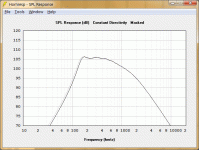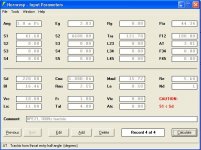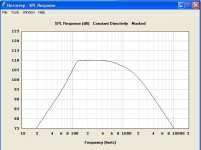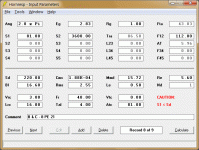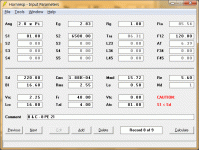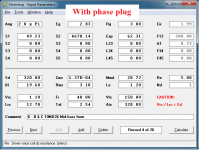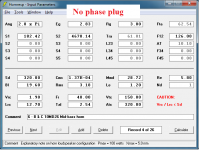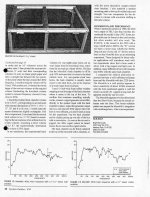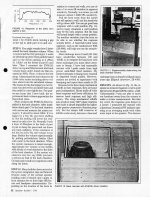Tell me how you'd measure the impedance curve, Dirk . I described my difficulties finding the peak a few posts back . If you have a better method then that would be very useful .
Buy WT2 and hook it up. It will trace the impedance curve for you.
Look at the size and scale of his sytem. A Radian 950PB is a toy compraed to the GOTO 505TT. If the GOTO driver isn't cutting it, what makes you think the Radian can do it?
hi John
why is the Radian a toy compared to the Goto ? Just because the Goto has a price tag 10 x higher ? Just because its " Goto " ? Its a proven FACT the Radian goes lower. Just compare the SPL plots.....
The span between the 53Hz horn and the 150Hz is too great due to the high horse power design of his system. You can't do things the same way - the scaling and requirements are completely different.
I think a compression driver that goes lower will match the requirements better, be a more elegant, and less complex solution. Just my 2 cents.....
You should never use any compression driver below its Fs. It's a poor design choice.
My ears tell a other story. 😉
I am trying to create a useable horn for my 8PE21s and I have a dilemma. The shot of hornresp below shows two similar tractrix horns, same driver, 81cm^2 throat, 86cm length. The darker plot has a larger 6,500cm^2 mouth (120Hz flare) and rear volume to tune to 130Hz. The pale "compare previous" plot is for a mouth of only 3,600cm^2 (but 112Hz flare), with slightly larger rear chamber to suit.
I would prefer the throat area and length to remain fixed.
So, if the smaller mouth gives the benefit of low extension due to the lower flare rate frequency, what would be the disadvantages?
I would prefer the throat area and length to remain fixed.
So, if the smaller mouth gives the benefit of low extension due to the lower flare rate frequency, what would be the disadvantages?
Attachments
I would suggest a 10" or 12" due to the scale of your current system and room size. Most of the low Qes pro sound woofers with light cones should be fine. I've worked with the B&C 10MD26 and it does very well in the 100Hz to 600Hz range. But, once again you might find some "softness" compared to the GOTO driver. A good phase plug design will help close the gap. You can also over dampen the tuning to increase the "attack".
Hello John, thanks a lot! I'll give the 10MD26 a try. Should I stick with a 4" throat with this driver? Does 120hz tractrix sound like a good choice? I am gonna try building it with a phase plug. Also, how many litre do you think the back chamber will be with the horn coupling to the floor? Thanks again!
Keith
hi Keith
i made the same experience as you, after i replaced the Fane Studio 8m with Radian 950pb. The difference of the Radian to your Goto is , that it goes lower. Vincent Brient measured useful output down to 220hz.
In my setup, i choose 300hz crossover point. And my bass horn keeps up well up to that frequency. Instead of inserting another horn channel, with all the difficulties to integrate it etc., why do you not try a compression driver in the lower midrange, that goes lower, to fill the gap ?
Angelo
Hello Angelo, thanks for your suggestion, I've actually read about the radian driver on your website. However, my 53hz midbass horn isn't good sounding at 300hz... even now, mating at 200hz with the 6I100 sounds a little sketchy. I don't think the radian would work at 220hz...
Keith
I am trying to create a useable horn for my 8PE21s and I have a dilemma. The shot of hornresp below shows two similar tractrix horns, same driver, 81cm^2 throat, 86cm length. The darker plot has a larger 6,500cm^2 mouth (120Hz flare) and rear volume to tune to 130Hz. The pale "compare previous" plot is for a mouth of only 3,600cm^2 (but 112Hz flare), with slightly larger rear chamber to suit.
I would prefer the throat area and length to remain fixed.
So, if the smaller mouth gives the benefit of low extension due to the lower flare rate frequency, what would be the disadvantages?
There's something off with your math I think. Lower flare rates (cut off frequency) require larger mouths, for the same designed space (1/2 space, 1/4 space, etc).
I've attached my plots for the 8PE21.
Attachments
To clarify, I'll show the input screens.
For the 112Hz horn, I get a throat area of 41cm^2 and a length of 66.1cm. For the 120Hz horn, I get a mouth area of 3194cm^2 and length of about 60cm. This is according to the spreadsheet I use. Both tractrix horns are in half space.
Last edited:
Ok, that's where we are differing in approach. I've already decided to have an 81cm^2 throat based on known good configurations in this kind/size of horn in general, and known good configurations with this driver. Similarly with the length, I've researched reasons not to have it any longer than this, or any shorter than this.
This just leaves me playing with the mouth. I will initially be building a rectangular horn, and placing it on the floor, hence my assuming a half space loading at this point.
This just leaves me playing with the mouth. I will initially be building a rectangular horn, and placing it on the floor, hence my assuming a half space loading at this point.
Ok, that's where we are differing in approach. I've already decided to have an 81cm^2 throat based on known good configurations in this kind/size of horn in general, and known good configurations with this driver. Similarly with the length, I've researched reasons not to have it any longer than this, or any shorter than this.
This just leaves me playing with the mouth. I will initially be building a rectangular horn, and placing it on the floor, hence my assuming a half space loading at this point.
If you intend to place the horn on the floor against a wall, try modelling it in 1/4 space instead of 1/2 space. That's what I did with this horn in Hornresp.
I am trying to create a useable horn for my 8PE21s and I have a dilemma. The shot of hornresp below shows two similar tractrix horns, same driver, 81cm^2 throat, 86cm length. The darker plot has a larger 6,500cm^2 mouth (120Hz flare) and rear volume to tune to 130Hz. The pale "compare previous" plot is for a mouth of only 3,600cm^2 (but 112Hz flare), with slightly larger rear chamber to suit.
I would prefer the throat area and length to remain fixed.
So, if the smaller mouth gives the benefit of low extension due to the lower flare rate frequency, what would be the disadvantages?
You'll never hear the difference in those two horns. There is no hard rules on how much you can "cheat" on mouth size. The only trade you're making is size vs. diffraction. Horn Response can help some. When you start to see ripples in the response you know you've gone too far.
Last edited:
Ok, that's where we are differing in approach. I've already decided to have an 81cm^2 throat based on known good configurations in this kind/size of horn in general, and known good configurations with this driver. Similarly with the length, I've researched reasons not to have it any longer than this, or any shorter than this.
This just leaves me playing with the mouth. I will initially be building a rectangular horn, and placing it on the floor, hence my assuming a half space loading at this point.
I think your back chamber volume is wrong. If you use Keele's formula, the back chamber volume is a function of the throat area. I calculate that you need about 4 liters for your 112Hz horn.
You'll never hear the difference in those two horns. There is no hard rules on how much you can "cheat" on mouth size. The only trade you're making is size vs. diffraction. Horn Response can help some. When you start to see ripples in the response you know you've gone too far.
JLH, I think it was you that suggested not going any longer with the 8PE21? Based on what you've said, and assuming the throat size is a good choice, the smaller mouth version of this horn I've suggested would seem to be the largest horn that need be (or could be) "successfully" used with this driver.
I was hoping to reach 120Hz, but it seems that would only be possible with just the right room placement?
Last edited:
Hello John, thanks a lot! I'll give the 10MD26 a try. Should I stick with a 4" throat with this driver? Does 120hz tractrix sound like a good choice? I am gonna try building it with a phase plug. Also, how many litre do you think the back chamber will be with the horn coupling to the floor? Thanks again!
Keith
These are my two suggestions. One is with a phase plug, the other is without. Note that part of the length includes the phase plug. The best part about building your own phase plug is you can carry the correct flare rate all the way from the plug to the end of the horn.
Attachments
JLH, I think it was you that suggested not going any longer with the 8PE21? Based on what you've said, and assuming the throat size is a good choice, the smaller mouth version of this horn I've suggested would seem to be the largest horn that need be (or could be) "successfully" used with this driver.
I was hoping to reach 120Hz, but it seems that would only be possible with just the right room placement?
The length in regards to high frequency performance was a joint observation made by Romy and I. If you want to reach 120Hz solidly, then it will have to be close to 100 cm long. If its going to be this long I would not try to use it above 400Hz.
Thanks, I'd like to go further up. 800Hz would be nice, but 400Hz won't cut it for my requirements. 120Hz does seem to be important though. As long as I could push it there with room placement, that seems to be the compromise I'll be chasing.
I think your back chamber volume is wrong. If you use Keele's formula, the back chamber volume is a function of the throat area. I calculate that you need about 4 liters for your 112Hz horn.
Get your head out of the text books and actually build something. Several other people have proven that Keele's formal does NOT work for reactance annulling for a tractrix horn. Stop misleading people based purely on theory. Even Bruce Edgar has shown that the formulas don't work. It didn't work with the Monolith or the Show horn. With the tractrix it goes the other direction. I have consistantly found that the tractrix requires a smaller volume than an exponential or hyperbolic horn.
Attachments
Thanks, I'd like to go further up. 800Hz would be nice, but 400Hz won't cut it for my requirements. 120Hz does seem to be important though. As long as I could push it there with room placement, that seems to be the compromise I'll be chasing.
If you are willing to use some high frequency compensation and move to a conical mid bass horn you can get your goal of 120Hz to 600Hz. Start playing with Horn Response and keep an eye on directivity as you work along.
Get your head out of the text books and actually build something. Several other people have proven that Keele's formal does NOT work for reactance annulling for a tractrix horn. Stop misleading people based purely on theory. Even Bruce Edgar has shown that the formulas don't work. It didn't work with the Monolith or the Show horn. With the tractrix it goes the other direction. I have consistantly found that the tractrix requires a smaller volume than an exponential or hyperbolic horn.
And you're lecturing me because why now? Are you violating the rules of this message board with this post?
- Status
- Not open for further replies.
- Home
- Loudspeakers
- Multi-Way
- Best 8" to 12" driver for 130hz tractrix horn
